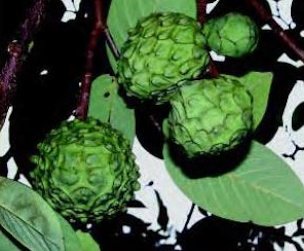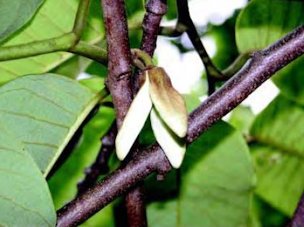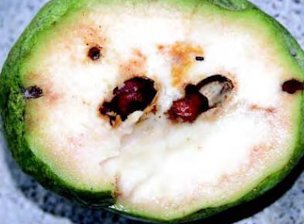From the Twelve
Fruits With Potential Value-Added and Culinary Uses
by Ken Love, Richard Bowen, and Kent Fleming
Cherimoya
Scientific name: Annona
cherimola
Family: Annonaceae
Origin: South America

Cherimoya,
considered to be one of the most delicious South American fruits, is
thought to have originated in Peru and Ecuador and has become
naturalized throughout the tropical highlands and subtropical areas of
South America. The spreading, low-branched trees can grow to 30 feet
tall but usually are kept shorter for ease of harvest. The leaves of
different cultivars and seedling trees vary a lot in shape and can be
from 3 to 10 inches long and 2 to 5 inches wide. The fruit also is
found in a wide variety of shapes and sizes with varying degrees of
U-shaped, smooth indentations or bumpy protuberances.
Cherimoyas
generally ripen 5–7 months after pollination. Ripe fruit can be
from 1 to 12 inches in diameter. The fruit contains numerous black or
brown seeds, which are easily separated from the pulp. Usually eaten
fresh out of hand, cherimoya is also used to flavor flan, sorbet, and
ice cream. The tree is believed to have come to Hawai‘i in the
1790s, although fruiting trees were first recorded in 1825. By 1920 the
tree had become naturalized in Kona and Ka‘ü on the Big
Island.
Cultivars
Of
the many cultivars of the fruit, a few popular types are
‘Bays’, ‘Whaley’, ‘Deliciosa’,
‘Chaffey’, ‘Booth’, and
‘McPherson’. In Spain, ‘Pinchua’ and
‘Baste’ are important. In South America, popular cultivars
include ‘Lisa’, ‘Impresa’,
‘Umbonada’, ‘Papilonado’,
‘Tuberculada’ and ‘Chevez’. Varieties differ in
smoothness of skin, number and size of protrusions, amount of seeds,
and extent of depressions in the skin. Trees producing seedless fruit
are sometimes reported. Seedlessness of fruit can be induced by
repeated applications of gibberellic acid.
Environment
The
subtropical cherimoya prefers higher elevations, to 5000 feet, but will
bear fruit as low as 800 feet. At lower elevations, however, trees seem
to be less productive and the fruit is more susceptible to insect
damage. Seedling trees have been planted at lower elevations in Kona in
hopes that a suitable selection can be found. Generally, atemoya (A. squamosa x A. cherimola)
is recommended for low elevations. Cherimoya prefers rich, loamy, well
drained soil with uniform moisture. The tree is drought tolerant and
does not tolerate standing water. Orchard trees are generally spaced
20–25 feet apart but can be closer if intensive pruning is
practiced. Seedling and grafted plants will bear fruit in 2–4
years given proper nutrition.
Horticulture
Shaping
the young trees is important to fruit production. Limbs need to be able
to support the heavy fruits, which can weigh more than 2 pounds.
Usually two or three lower limbs that angle upward at about 60 degrees
from the trunk are saved. The pruning style adopted in many production
areas is called the open goblet. Prune during the rest period when
leaves begin to fall shortly after harvest is completed. Tip rapidly
growing shoots to encourage flowering.
Apply a balanced
fertilizer, such as 6-6-6, quarterly. In the 12 Trees Project, under
conditions of above-average initial soil fertility, one-year-old trees
received 1⁄2 pound yearly; two-year-old trees received 1 pound
yearly. Where soil fertility is not above average, these amounts can be
doubled. An additional pound per year of growth until 5 pounds is
reached is recommended. In producing orchards, various N-P-K
formulations are used, depending on the soil nutrient status.
UH-CTAHR’s
Agricultural Diagnostic Service Center can analyze soil and offer
recommendation for soil amendments; this fee-based service is available
through Cooperative Extension Service offices statewide. Cherimoya
usually requires extra potassium for good production, up to 10 pounds
per year for mature trees. Leaf yellowing can be an indication of the
soil being too wet or too dry, or it can be caused by rapid temperature
changes, nutrient deficiencies, or soil pH below 5.5 or above 6.5.
Pollination
Cherimoya
usually does not ordinarily yield heavily in Hawai‘i. Its flowers
contain both male and female organs, but they mature at different
times. In major cherimoya growing areas in New Zealand and California,
hand-pollination or a pollination gun is used to ensure good fruit set
and result in fruits that are more uniform in size. Pollination needs
to be done when the female flowers are receptive, over a 6–8 hour
period. Pollen is collected in the afternoon from partially opened
flowers and transferred by brush to the stigmas of female-stage
flowers, either just after collection or the following morning (with
pollen refrigerated overnight). This process is usually repeated for 4
or 5 days during peak flowering.

Cherimoya flower
Observations
in South Kona revealed that when the often-flowering soursop (Annona
muricata) is planted among cherimoya trees, the cherimoya
produces more
fruit than in locations where soursop is not planted, possibly because
more pollinators are attracted to the area.

Annona
seed wasp damage
Propagation
In
Hawai‘i, cherimoya cultivars are often grafted onto seedling
rootstocks of cherimoya or another annonaceous fruit such as soursop (A. muricata), pond
apple (A. glabra),
or custard apple (A.
reticulata). The sugar apple (A. squamosa)
is used as a rootstock in other locations where the cherimoya is grown,
but it has not adapted well to Hawai‘i. Airlayers and cuttings
are not very successful ways to propagate the tree. Seeds can remain
viable for up to two years. Soursop rootstock is commonly used in the
Kona district, often with one soursop vertical remaining so that the
tree will be more attractive to insect pollinators (and also produce
both types of fruit).
Pests and
diseases
The annona seed wasp (Bephratelloides
cubensis),
first reported in Hawai‘i in 1986, has caused extensive damage to
both commercial and backyard growers on O‘ahu and the Big Island.
The insect tunnels through the fruit after devouring the seed as
larvae. The emergence holes on the developing and ripening fruit cause
rapid decay and easy access for ants and other insects attracted to the
fruit. Infested fruit needs to be removed from the orchard to reduce
breeding grounds and prevent reinfestation. Using protective wrapping
(fruit bags) after fruit set will also prevent damage from the insect.
Cherimoya is also susceptible to anthracnose (Colletotrichum gloeosporioides),
which appears as dark spots that can produce pink spores. Black canker (Phomopsis anonacearum),
which appears as hard or cracked purple spots on the surface, is also a
problem. Botryodiplodia
rot (Botryodiplodia
theobroma)
causes the flesh to become brown and corky. These diseases can be
minimized with good field sanitation practices and approved fungicides.
Harvesting
and yield
Yields
vary greatly depending on pollination practices. Five-year-old trees
that have not been artificially pollinated can produce 25 or more
fruits per season. Thirty-year-old trees in Italy have produced up to
300 fruits. Hand pollination tests in New Zealand produced up to 100
fruits per tree.
Timing of harvest is crucial, and care must be
taken with harvested fruit. If picked too early, the fruit will not
ripen properly and will become mealy. Overripe fruit can split,
resulting in rapid decay.
Packaging,
pricing, and marketing
Harvested
fruit for wholesale markets are generally sized and packaged in single
layers to prevent bruising. Ripe fruit should be kept at
32–41°F. Stores selling unripe cherimoya often put them in
chilled sections of the produce department, which will prevent the
fruit from ripening. Unripe fruit should not be chilled and should
kept at 68–73°F. It can be stored at 50–55°F with
90–95% relative humidity for two to three weeks. In
Hawai‘i, cherimoya is sold by weight; 2005 wholesale prices
ranged from $1.50 to $2.50 per pound, while retail farmer’s
market prices were as high as $5.95 per pound. In some retail
locations, individual fruits are placed inside foam netting to prevent
bruising.
Possible
toxins
The
seeds of cherimoya contain several alkaloids (anonaine, liriodenine,
and lanuginosine) that should be considered poisonous. In some places
the seeds are crushed and used as insecticide.
About
the Twelve Fruits With Potential Value-Added
and Culinary
Uses Project
Back to
Cherimoya
Page
|
© 2007, University of Hawai'i
|